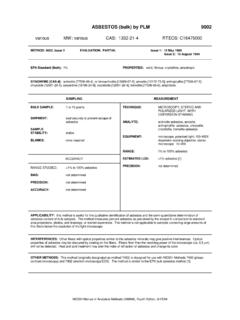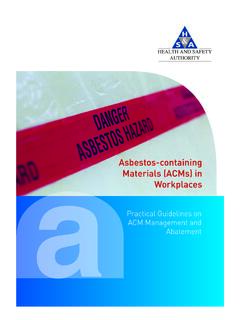Transcription of Red Flags for the CSA - Bradford VTS
1 Red Flags for the CSA and RCA Drs. Ramesh Mehay, Paul Lord & Junaid Azam. Bradford GP Training Scheme 2014, updated Oct 2021 During clinical practice observations, we've noticed that a number of GP trainees do not ask the full comprehensive set of questions that help exclude the serious differentials. You can't just ask a few of them and then think you are done! So here's a list of essential things to ask in the history to pick out the red flag stuff ( whether something serious is going on or not). This will help you in the CSA/RCA exam and in your GP consultations after that. It will help reduce the chances of you missing things and thus enhances patient safety. You need to be familiar with this data set like the back of your hand. Of course, there will be other questions you need to ask in the history which are not included here, but these additional questions will usually centre on refining your diagnosis rather than excluding something serious going on.
2 Including these would make the document too lengthy and unworkable. We hope you find this document helpful as it stands. RED Flags THAT INDICATE SOMETHING MEDICALLY SERIOUS MAY BE GOING ON HEAD & NECK Headache Intracranial mass: vomiting, waking from sleep, double vision, fits/faints/funny turns, h/o cancer anywhere Meningitis: duration acute, rash, neck stiffness, photophobia, fever, confusion/LOC Temporal Arteritis: acute duration, tender temporal arteries, jaw claudication (pain on eating, pathognomic!) SAH: acute SEVERE headache, 'sudden hit on the head', occipital, stiff neck, N&V, photophobia, blurred/double vision. (10% of all occipital headaches are SAH; most common is cervicogenic headache). Note: a thunderclap headache ( sudden onset headache which reaches maximum intensity within seconds-minutes); seen in subarachnoid haem.
3 , cerebral venous sinus thrombosis and cervical artery dissection. Migraine: 3 item test: (i) acute unilateral pulsating and disabling headache, (ii) Nausea (present in 75%), (iii) photophobia (85%). Sensitivity of these 3 items: 80%; specificity: 75%. Additional symptoms: phonophobia (75%), vertigo (50%), vomiting (30%), aura (in 20%). Did you the PPV of a headache symptom alone for a brain tumour is In other words, if you have a headache, there's only a chance of it being a brain tumour. On the other hand, a new onset seizure has a PPV of for a brain tumour. only 10% of patients with a brain tumour ever report a headache before the diagnosis. All Eye Symptoms Visual acuity changes and diplopia most important questions. Also ask about - sudden onset pain & redness, floaters, haloes, visual field defects Epistaxis Nasal obstruction, nasal discharge with or without blood, facial pain, double vision Hoarseness, Mouth Ulcers, Neck Lumps Hoarseness >3w, dysphagia, long lasting cough (>3w), long lasting sore throat (>3w), or lump in neck or persistent mouth ulcers (higher suspicion if age>45) Ask about alcohol or smoking history increased risk of oral/laryngeal cancer.
4 Dental swelling: (mnemonic PUSTULES) Pyrexia, Unwell (tachycardia, tachypnoea, hypotension), Swelling (extra-oral), Tender, Unable to swallow secretions ( drooling), Limitation in opening, Eye involvement (periorbital cellulitis), Speech problem These need referral could be abscess or malignancy THORAX Cough Duration > 3w, haemoptysis (v worrying symptom), SOB, chest pain, recurrent/persistent chest infection, hoarseness, dysphagia, weight/appetite loss, fatigue (higher suspicion if age>40) Ask (i) if ever smoked or (ii) exposure to asbestos Chest pain/Palpitations Exertional chest pain, palpitations, SOB, syncope, FH heart problems/sudden death. Note: if palpitations present, ask whether exertional (more worrying) and if any syncope.
5 Shortness of Breath 1. Is it respiratory? (ask about presence of cough, PMH COPD/Asthma etc., smoker) a. If so cough, haemoptysis, hoarseness, dysphagia, apetite/weight loss, fatigue, FH thrombosis (re: PE?) b. Ask about occupational history: dusts (mining & mills), asbestos (engineering & plumbing). 2. Is it cardiac? (ask about chest pain, sob orthopnoea & PND, cardiac history) a. If so chest pains, palpitations, syncope, FH hearth problems/sudden death b. Note: In HF, central fluid overload symptoms (exertional nature of SOB, orthopnoea and PND) are actually more significant than peripheral fluid overload symptoms like ankle oedema. Red Flags for the CSA and RCA Drs. Ramesh Mehay, Paul Lord & Junaid Azam. Bradford GP Training Scheme 2014, updated Oct 2021 ABDOMEN Lower GI symptoms: change in bowel habit, constipation, diarrhoea, PR bleeding or abdo pain Change in bowel habit, unexplained PR bleeding, diarrhoea, vomiting, tenesmus, weight loss (esp with abdo pain), FH GI cancer (higher suspicion if age >50) If also Fe deficiency refer.
6 Diarrhoea ask about foreign travel and fever (rigors/chills). Upper GI symptoms: dyspepsia/heartburn Dysphagia, weight loss are the main red Flags (higher suspicion if age>55) Also check lower GI red Flags above. Remember to check it is not angina. Upper GI symptoms: Pancreatic Ca >60 w wt loss and any of: diarrhoea, back pain, abdo pain, N/V, constipation, new/worsening diabetes OR >40 and jaundice PELVIS Urinary symptoms Visible haematuria, recurrent UTIs, recurrent visible haematuria after UTI treatment , weight loss, prostatic symptoms in men (urgency, frequency, nocturia); (higher suspicion if age>45) If age>60 with dysuria dipstix the urine: if non-visible haematuria present, needs referral SKIN Any skin lesion 2 points each: change in size, irregular shape, irregular colour 1 point each: diameter 7mm, inflammation, oozing, change in sensation 2 or more points refer BONES & JOINTS & LIMBS Back Pain Cauda eq.
7 Syndrome: urinary retention/incontinence, faecal incontinence, saddle anaesthesia (unable to feel tissue paper on wiping bum), lower limb weakness, sexual dysfunction. Ask re: h/o. malignancy. Malignancy: age <20 or >50, nocturnal pain, thoracic pain, prev malignancy If weight loss: think of tumour, TB (cough>3w, haemoptysis, night sweats, fatigue, foreign travel) and HIV (night sweats, fatigue, swollen glands, achy muscles/joints, oral thrush, pneumonia, chronic diarrhoea). Joint symptoms Septic/Inflammatory arthritis: Swollen, red, hot, tender, systemic upset? Malignancy: bone pain, nocturnal pain, rest pain, weight loss, h/o previous malignancy A red flag in a child might be avoidance of using a joint plus systemic upset (osteomyelitis/septic arthritis).
8 This can sometimes be very difficult to diagnose, especially in tiny tots. Critical ischaemia: Gangrene or (6 Ps): Pain at rest, Pallor, Perishing cold, Paraesthesia, Pulseless, Paralysis NEURO Fits/Faints/Funny Turns/LOC V. important to get an accurate history of what went on: hence, the importance of the witness and if frequent the opportunity of a friend/family filming the event on their smart phone is almost always the way to diagnosis 1. Is this neurological? Loss of consciousness, fits, tongue biting, urinary incontinence. Presence of an aura or precognition that there is to be an event (de ja vu, hallucinations of smell/taste). 2. Is this cardiac? Chest pains, palpitations, FH sudden death/heart problems. Tunnel vision (hypoperfusion of distal retina) and weak legs (hypoperfusion of the cerebral cortex) suggest cardiac too.
9 3. Is this vascular? Facial weakness, hemiparesis, slurred speech MENTAL HEALTH Depression Low mood > 2w, irritability, anhedonia (general & sexual), loss of concentration, sleep problems initial insomnia +/- disrupted sleep +/- early morning wakening, appetite loss, weight loss/gain. (The 'biological features' of depression) Ensure not bipolar any episodes of mania in between the low moods? Ensure no psychotic symptoms hallucinations, delusions Any suicidal plan? Work out suicidal risk (see below) Also worthwhile asking about anxiety as mixed affective disorders are common (see below) Red Flags for the CSA and RCA Drs. Ramesh Mehay, Paul Lord & Junaid Azam. Bradford GP Training Scheme 2014, updated Oct 2021 Anxiety Always worried or on edge, feels anxious/losing control/going crazy, overwhelming panic, breathing trouble/choking sensation, hyperventilation, hot flushes, trembling/shaking, perioral tingling.
10 Check for depressive features see above and assess suicidal risk. Suicidal Risk The 5 Triage Questions: 1. "Are you able to keep yourself safe until this assessment is completed?" [No refer] 2. "Are you in possession of a gun/weapon/have easy access to a gun or weapon?" [Yes refer] 3. "Have you felt like hurting yourself?" [Yes refer] 4. "Have you felt like hurting anyone else?" [Yes refer] 5. "Have you already hurt yourself or anyone else?" [Yes refer] If response to 5 triage questions is okay, then go on to working out their Suicidal Risk. o The areas below are intended to help health professionals conduct a thorough assessment by stimulating an enhanced line of questioning, enabling them to formulate an overall impression. o Assessment of Suicidal Risk: (IIPPS) Ideation - Plans, Lethality & Means (PLM) Intent assessment: Desire to die, no feelings about effect on Others, no Guilt, Hopelessness (DOG-H) - these 4 things are worrying.


